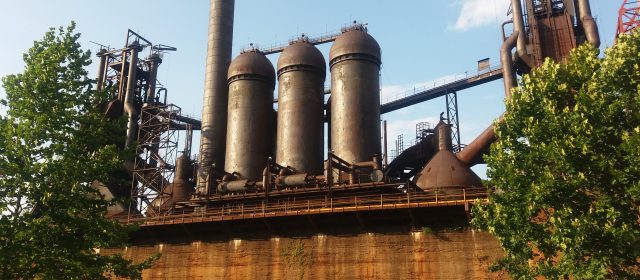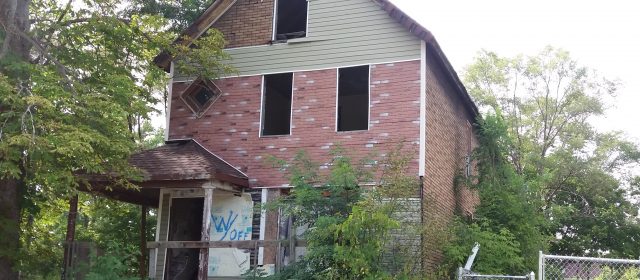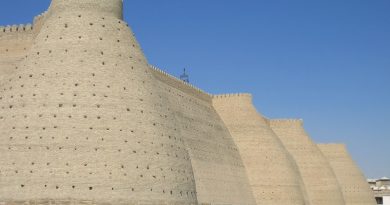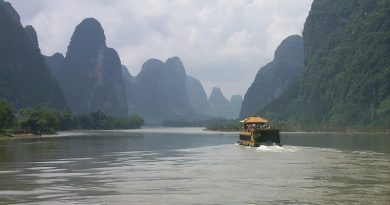American Titans: The Rust Belt
Today, the Rust Belt is the economic region of the United States concentrated in the formerly dominant industrial states of Illinois, Indiana, Michigan, Ohio, and Pennsylvania.
The area we know as ‘The Rustbelt’ was coined by democratic presidential candidate Walter Mondale in the 1980s in lament for the sad decline of America’s steel and manufacturing industry. Originally called the Rust Bowl – the press misquoted it and the name has stuck.
The Rust Belt had the mighty reserves of what a great industrial nation needed to kick off: coal, iron ore, labour and inland waterways. The region drew the greatest labour force in the western world – from European immigrants to African Americans fleeing the shackles of a slave south.
Buffalo, New York State
A brutal Civil War had divided America and work and industry were to unite it. A route from
New York to the West Coast was how America first got connected – with transportation of goods from the Eastern seaboard, across the Great Lakes onward by water and, by 1870, by rail.
Erie County, on the western side of New York State, was the conduit where this could first happen and, in 1825, Buffalo was the town that made it happen. The Lake Erie Canal, opened up the Eastern seaboard to trade with the rest of the USA.
Grain was the big produce at the heart of this trade. Transporting Midwestern grain became an industry in itself. The Silo Rocks grain elevator, in Buffalo, was one of the first examples of mechanical engineering.
Buffalo, located on the Canadian border next to Niagara Falls, became known as the ‘City of Light’. Edison and Tesla were associated with the city which was the location of first power station to light up the Eastern seaboard.
In the late 19th and early 20th centuries industrial millionaires lived here in 8,000 square feet mansions designed to their peculiar taste.
Cleveland, Ohio
One hundred and ninety miles west across Lake Erie is Cleveland, in the State of Ohio. Cleveland’s freight trade centered on iron ore, mined in Wisconsin. Together with the supply of coal from nearby Pennsylvania, this led to the creation of steel plants in the Rust Belt. The waterways offered a means to get to and fro and an industrial revolution equal to England’s own took off only a few years later.
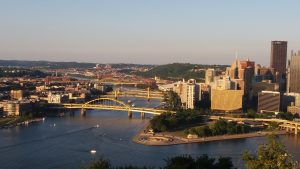 Known as “ The Mistake on the Lake” , a recession made Cleveland bankrupt in 1976.
Known as “ The Mistake on the Lake” , a recession made Cleveland bankrupt in 1976.
But the wealth of a steel industry had already created a diverse cultural scene. Rock’n’Roll was coined here by DJ Alan Freed in a small record store and the city is now home to the Rock and Roll Hall of Fame.
Rust Belt Titans
JD Rockefeller
Kerosene was the fuel that transformed America when it lit up homes and made gasoline after some diligent refining. JD Rockerfeller exploited the kerosene business in Cleveland like no other when he created one of the first corporations, Standard Oil, in 1870. He was one of the Rust Belt’s original Titans.
Cornelius Vanderbilt
A tough ferry boat owner from New York who bullied his way to the top of the railroad ladder, Vanderbilt was the man who united America’s rail network which sealed America’s industrial revolution. He joined forces with oilman John Rockefeller to fill his empty trains with cargo and suddenly the USA had light and fuel that could be transported across its vast nation.
Andrew Carnegie
Pittsburgh created the Rust Belt’s next titan and robber baron – Scottish steel-man Andrew Carnegie. He made a fortune by replacing unsafe iron with steel in railroad tracks. His
Pittsburgh steel mill was destined to be the world’s biggest. Carnegie sold his mills to the banker JP Morgan for the equivalent of US$360 million, He donated most of it to acts of charity and philanthropy.
But philanthropic Andrew Carnegie wasn’t an angel in his working life. Like most of the men who built America he was ruthless in his ambition to be the best and earn the most – and even if he was the nation’s biggest steel producer it was never enough. And he would do anything to maximise profits, even at the expense of his workers.
Pittsburgh, Pennsylvania
The 18th century discovery of coal deposits turned Pittsburgh into a steel-making hub. A
growing steel industry attracted European migrants and created a patchwork of communities: German, Irish and Italian.
A German émigre, Henry Johnson Heinz, was a humble horseradish seller who marketed his product in a clear glass bottle and then made the second largest condiment in the world in 1875.
Coal Hill (now known as Mount Washington) was where 1 billion tons of black gold has been unearthed since 1760.
A funicular railway was created here by German workers to lug the coal up and down the valley. These inclines were based on the “steilbahns” (cable-run cars) back home in Germany.
The summit atop Coal Hill became the residential district for the coal and steel workers as so many factories occupied the lower ground.
The Homestead steelworks produced more structured steel than anywhere on earth but Steel magnate Andrew Carnegie was jealous that for all his output, his titan rival, John Rockefeller was still richer than him. A battle between the ‘Man of Steel’ and the ‘Man of Oil’ ensued.
Birth of the Unions
Andrew Carnegie got his headman, Henry Frick, to overwork his poorly paid labourers – 40 hour weeks and 6 days of slogging in a furnace. There were injuries. Workers passed out. The workers then got together and a strike ensued. Carnegie and Frick would not give in to the workers’ demands for better pay and lesser hours and when the workers locked out the mill, Frick employed Pinkerton detectives to break the strike. Nine people were killed as the detectives opened fire against unarmed Homestead steelworkers. There was national outrage. This is the start of the American union movement and anti-trust laws that set out to break up the monopolies of the huge conglomerates in the early 20th century.
Oil & the Motorcar
The development of the horseless carriage is at the heart of the the Rust Belt’s relationship with automobiles. Many early companies had previously built stage coaches.
In 1913 cars were still mostly powered by ethanol, steam and electricity but John Rockefeller’s relentless analysis of the waste products from crude oil led him to gasoline and as luck would have it, his discovery coincided with the invention of the internal combustion engine. The petrol station was born.
Akron, Ohio
Akron, like our other locations, grew with the building of the canal. Like Buffalo it imported grain and soon made cereals. The discovery of clay led to the building of sewage pipe factories. A factory base expanded its output; rotational mouldings led to Akron being a leading toy manufacturer.
Akron became a perfect site to attract the latest scientific discovery. And it did this when vulcanized rubber was mass produced to make the wheels of the bicycle and the every growing motorcar.
Akron became known as the “rubber capital of the world”. But the automobile industry that made Akron’s fortunes, sank it too.
Goodyear and Firestone
Civic leaders gave New York rubber entrepreneur BF Goodrich $13,600 to set up shop in Akron. In his lifetime he was a failed businessman but his company survived and developed a pneumatic tire pioneered by Michelin in France in 1898. Goodrich patented the radial tire and in the same year, Frank Sieberling bought the patent to Charles Goodyear’s vulcanized rubber invention and established the Goodyear Rubber and Tyre Company. Goodyear had accidentally invented a rubber that did not goo in the heat nor become brittle in the cold. Goodyear spent years and all his savings trying to vulcanise rubber, using cream cheese and witch hazel in his chemical concoctions.
Goodrich died almost bankrupt, as did Goodyear and many others. But without their crazy obsessions where would the USA stand today?
By 1900 Akron was the fastest growing city in America. Harvey Firestone set up business here in 1900. Firestone was a friend of Henry Ford and he would end up supplying the tires for Ford’s Model T .
By 1950, more than 130 different companies manufactured rubber in Ohio, employing more than eighty-five thousand workers.
Today the names of rubber and tire pioneers Goodyear, Goodrich and Firestone are still associated with the Akron and the state of Ohio.
The Soap Box Derby
In 20th century America, boys of all age and sizes were drawn to the excitement of the automobile. Every kid wanted to be a racer – so they built gravity-powered, motorless cars a out of soap crates and roller blade wheels, and raced them downhill across the country. Nowadays, every August, Akron stages the All American SoapBox Derby race.
The derby grew out of the Great Depression. The automobile industry was in decline – half the number of GM cars were sold. So half an unemployed nation took to building cars to while away their boredom .
The derby transferred to Akron in 1935 when a depression era Federal Public works programme sanctioned the construction of the racetrack. It gave jobs to 30,000 locals.
Toledo, Ohio
“Toledo, Ohio” was not the pious, medieval capital of Spain but a slumbering town watered by the Erie Canal when it was completed in 1845. That year industry was planted – railway manufacturing and glassworks – but it was the wholesale of American‘s great automobile export , the Jeep, which made Toledo’s fortunes.
The Jeep
“Faithful as a dog, strong as a mule, agile as a goat” – the jeep’s invention was typical of American seat of your pants necessity.
It replaced the horse as the mode of transport to cross unruly terrain at speed. It was the messenger, the personnel carrier and the cavalry charge and it was born in World War II.
 The Germans were engineering masters since the days of Von Bismarck and they won battles on their surprise, rapid attacks – the blitzkrieg. They invented the Panzer tanks and VW bucket car – to carry out their blitzkrieg raids in World War I.
The Germans were engineering masters since the days of Von Bismarck and they won battles on their surprise, rapid attacks – the blitzkrieg. They invented the Panzer tanks and VW bucket car – to carry out their blitzkrieg raids in World War I.
A jealous US military gave manufacturers 49 days to create a rival to the bucket car. Out of 125 companies only two were up to the task American Bantam (with its 15 employees fending off bankruptcy) and Willy’s Overland. Bantam won the project and, led by Detroit engineer Karl Probst, they cobbled parts from garages around the state of Ohio to create the American Jeep we love today.
They made six prototypes. Tested to drive through woods and unruly terrain, it was fast and much more agile than the military could hope for and do more than expected. An engineering wonder, a 60 horsepower engine meant the Jeep could tow half of its own weight. It was the first vehicle to be a four-wheel drive. It featured combat lamps, a manual handcrank to start the engine, blackout lighting system, a gerry can equipped with five gallons, hand wipers and cover for jeep lights which folded to avoid detection.
The Ford Motor Company called their model the JPW and it was abbreviated to ‘JEEP’. But American Bantam could not produce en masse for the army. So Willy’s Overland and Ford supplied the army once the USA entered the war in December 1941.The first jeep was delivered by Willy’s in November 1941 – one month before the Japanese bombed Pearl Harbour and the US entered the war.
63,000 jeeps were built in five plants at a rate of 500 a week. Each platoon had a Jeep. Soldiers became dependent on the Jeep. Each platoon had a Jeep and its capabilities led General Eisenhower to declare that three things won the allies the war – and the Jeep was one of them.
Returning GIs became attached to the Jeep and wanted to drive them back home, so Willy’s and the Ford Motor Company started thinking about advertising and modernising. The rest is history. The Jeep’s future was assured.
Detroit, Michigan
Detroit is a city like London that was reborn from a fire whose flames licked all the wooden houses back in 1805. Here the city was rebuilt in glass and steel with industrial revolution technology and Chicago-based architectural nous.
It was here that Henry Ford procured a licence to produce his Model T. He invested in an automated production line churning out four cylinder cars that could be bought for as little as $900.
Detroit Mansions
The mansions weren’t owned by merchants but the big car magnates: Charles Lambert of Regal Motors, Henry Joy of Packard and The Fisher brothers. And and most conspicuously, a 20th-century fortress by America’s iconic architect Frank Lloyd Wright – the Henry Ford Estate, aka Fairlane House.
Fairlane was Henry Ford’s and his wife’s sanctuary. It was his 15th home, built in 1915 at a cost of $1.8 million. It covers 1,300 acres and has a bowling alley inside. It’s self sufficient in electricity as Henry Ford and Thomas Edison designed the power supply – two turbines humming underground amply providing heat, light, a telephone and ice.
Downtown Detroit
Today, the real Detroit is a post apocalyptic graveyard of former glories, with a deserted Highland Park Ford motor plant as testament to a golden age of industrial innovation. Graffiti, voluntary groups, soup kitchens – this is present day, bankrupt, poor, desperate Detroit.
The city was abandoned – certainly by whites, who make up only 10-20 per cent of the population – after the automobile industry declined with foreign competition and a more efficient and cheaper way of making cars took root in the 1970s. There are a staggering 76,000 empty buildings scattered about Detroit’s shattered landscape. How does one even try to rebuild?
In its heyday, Henry Ford’s perfection of the production assembly line made Detroit a magnet for the unskilled and under-represented in America. The city attracted immigrants and a black population from the south, from cities like Louisiana and Kentucky. They came here to find a land of milk and honey. But a welfare capitalism created by Henry Ford himself, when he promoted the five dollar day, also undermined the industry’s longer lasting future as it was high wages which drove the companies out of Michigan. The unskilled remained and most of them had no voice.
Motown
Afro-Americans had to develop their own talents and there was plenty of that on the streets. In Detroit, this singing, dancing and entertaining talent gave black capitalism its first platform. That’s when Motown records was created.
Berry Gordy and Smokey Robinson were agog that America’s 4th largest city did not have an independent record label. So they mined Grand Boulevard West and amassed a talent pool that created the black sound of America.
 Berry Gordy was an a production line automobile worker and he learnt to mass produce records in the same way Detroit was mass producing cars and selling them to the world: create something everyone wants, make it quickly, copy it and sell again! The challenge was how to make something everyone wanted. Well, automobile worker Gordy knew that most people listened to music on the car radio. So he had his engineers and composers arrange music to fit the tinny sound of a car radio. It was a magic formula of bass line, drums, horns and backing vocals.
Berry Gordy was an a production line automobile worker and he learnt to mass produce records in the same way Detroit was mass producing cars and selling them to the world: create something everyone wants, make it quickly, copy it and sell again! The challenge was how to make something everyone wanted. Well, automobile worker Gordy knew that most people listened to music on the car radio. So he had his engineers and composers arrange music to fit the tinny sound of a car radio. It was a magic formula of bass line, drums, horns and backing vocals.
Of course add the black experience into the mix and whites couldn’t get enough of this music. It was soulful, joyful, melodic, groovy and terribly catchy.
Detroit is the birthplace of Motown Records and this legacy has left a creative impression on the city.
Milwaukee, Wisconsin
Milwaukee – a name derived from the Algonquian Native American Indian word meaning “pleasant land”- featured a natural harbour connected by lakes and canals to the East and 10 rail lines to the West. No wonder this metropolis bloomed in the industrial revolution. Milwaukee delivered the 20th-century slogan of its advertising poster “to feed and supply the world”
Miller’s Beer
In the 19th century, an oppressive agricultural feudalism in Germany forced a lot of poor farmers to the only place that would take them: America. Five million total came here and most of them were government-hating, Catholic-exiled, wheat farmers who brought with them a hatred for religious intolerance and skills in beer making.
It was therefore inevitable that Milwaukee would become s great exporter of cash crops and, with the discovery of iron ore in nearby Dodge City, Milwaukee was destined to become a manufacturer, especially of agricultural machinery. Combine mechanisation with agriculture and soon there were flour mills aplenty. Milwaukee started making its living in wheat-related industries, the most famous of them being beer-making!
There were 138 taverns in Milwaukee by 1843. By 1856 there were 24 breweries. They included Pabst, Miller, Schlitz and Blatz. Milwaukee became the beer capital of the USA.
Harley Davidson
Twelve years before Carl Wickman created the Greyhound bus service, two mates and a handful of relatives – Willam Harley and Arthur S Davison – were too lazy to pedal their bicycles to work. So they made a loop frame and cradled an engine in it. They called America’s first motorbike the Harley Davidson.
The Harley is a motorbike that crosses all class and cultural divides. Hollywood celebrities to print makers ride it. Each Harley is individual. It can be custom built and adapted.
The motorbike had been invented in 1895, in Germany by mechanical engineer William Daimler who designed the carburetor and the internal combustion engine which allowed gasoline to power his motorised bicycle.
The the first Harley used a tomato can for a carburetor! To start up the engine, you had to pedal the bike standing still and wait for engine compression to commence. The breakthrough came in 1909 when the V twin engine was designed. The motorbike could now travel at 60mph. The new engine created the distinctive sound of a Harley Davidson that everybody loves to this day.
The Harley motorbike was now raced. It even had its own racing team. Hollywood celebrities like Clark Gable and the starlet Gene Tierney brought the Harley Davidson to a worldwide audience. Marlon Brando made it a rebel machine and in the 1970s, the counterculture movie “Easy Rider” introduced the world to the ‘Hydra-Glide’, made famous by its stars and stripes fuel tank and chopper forks..
The Rust Belt Now
America’s Great Depression, the 2008 financial crash and the challenge of industrial survival in a competing world has meant the spirit of ingenuity and human achievement has been stifled by an enveloping stupor of sad, industrial decline.
Dan Gilbert is Detroit’s wealthiest CEO. He is Detroit born and raised; a professed champion of the city. His motto is “to do well by doing good.” He believes that a knowledge-based economy is where the Rust Belt’s future lies.
Despite depression, there is great infrastructure, raised by a century of industrial achievement. There are railways and waterways, and 50 per cent of imports from Canada still pass through Detroit.

